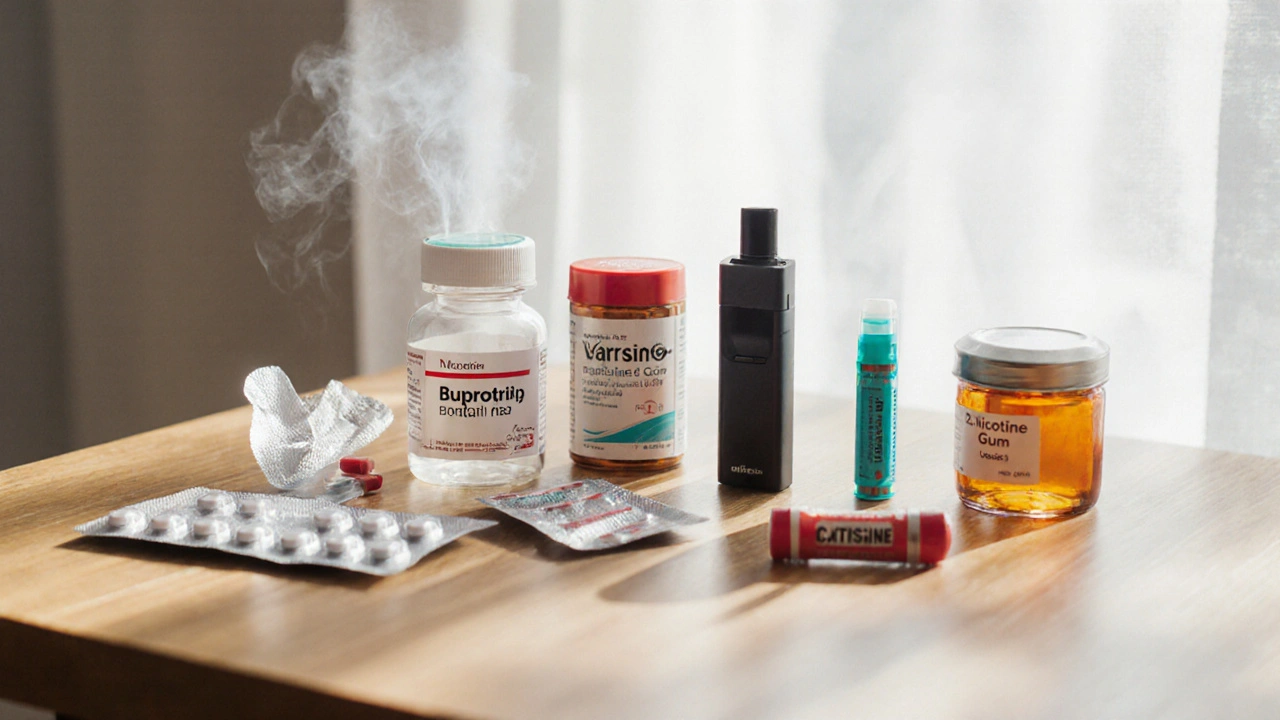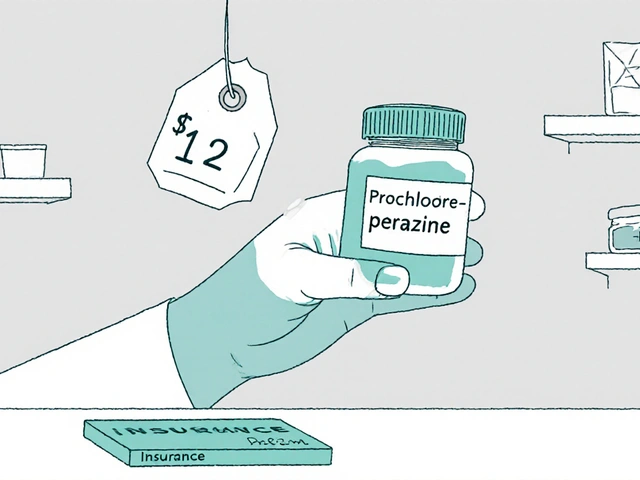Smoking Cessation Aid Comparison Tool
Compare Smoking Cessation Aids
Select an aid below to see detailed information about its effectiveness, side effects, and cost.
Effectiveness Comparison
| Aid | 12-Week Quit Rate | Side Effects | Average Cost (12 weeks) |
|---|---|---|---|
| Varnitrip (varenicline) | 30% | Nausea, vivid dreams, insomnia | £120 |
| Bupropion | 25% | Dry mouth, insomnia, tremor | £80 |
| Nicotine Patch | 20% | Skin irritation, sleep disturbances | £45 |
| Nicotine Gum | 15% | Mouth soreness, hiccups | £30 |
| Cytisine | 22% | Nausea, headache | £25 |
| Nicotine Inhaler | 18% | Throat irritation, cough | £70 |
Trying to quit smoking feels like staring at a brick wall: you know there’s a way through, but the right tool can make all the difference. Varnitrip is a brand name for varenicline, a prescription medication that targets nicotine receptors in the brain to lessen cravings and withdrawal symptoms. It’s been on the market for over a decade and is often pitched as the go‑to pill for smokers who’ve tried other methods without success. But is it truly the best option, or do cheaper or safer alternatives deserve a look?
Quick Takeaways
- Varnitrip works by partially activating nicotine receptors, which reduces cravings and makes smoking less rewarding.
- Quit rates for Varnitrip hover around 25%-30% after 12weeks, higher than most nicotine replacement products.
- Common side effects include nausea, vivid dreams, and mood changes; severe neuropsychiatric events are rare but reported.
- Alternatives such as bupropion, nicotine patches, gum, lozenges, inhalers, and cytisine each have distinct pros and cons regarding effectiveness, cost, and safety.
- Choosing the right aid depends on personal health, budget, and how you prefer to manage cravings (daily pill vs. as‑needed nicotine).
Let’s break down each option, compare the numbers, and figure out which path fits your lifestyle.
What Is Varnitrip (varenicline) and How Does It Work?
Varnitrip belongs to a class of drugs called partial agonists. It binds to the α4β2 nicotinic acetylcholine receptors in the brain, the same spots nicotine latches onto. By doing so, it does two things at once: it eases withdrawal by giving a low‑level stimulus, and it blocks nicotine from delivering its usual “reward” feel if you slip and smoke.
Typical dosing starts with 0.5mg once daily for three days, then 0.5mg twice daily for the next four days, finally moving up to 1mg twice daily for the remaining 11 weeks. Most doctors recommend a gradual taper over another 8‑week period to keep cravings low.
Alternative Options on the Market
When you ask a pharmacist about quitting aids, you’ll hear a handful of names. Below are the most common alternatives, each with its own mechanism.
Bupropion is an atypical antidepressant that also helps smokers quit by influencing dopamine and norepinephrine pathways, which are tied to reward and mood. It’s sold under brand names like Zyban and usually taken as a 150mg tablet twice daily for 7‑12 weeks.
Nicotine Patch delivers a steady dose of nicotine through the skin, ranging from 7mg/24h (light smokers) to 21mg/24h (heavy smokers). Patches are applied once daily for 6‑8 weeks, then the dose steps down.
Nicotine Gum provides short bursts of nicotine when you chew it, typically in 2mg or 4mg strengths, used on an “as‑needed” basis for cravings.
Nicotine Inhaler mimics the hand‑to‑mouth ritual of smoking, delivering nicotine vapor without combustion. It’s a small device that you puff on for up to 6mg per day.
Nicotine Lozenge dissolves slowly in the mouth, releasing nicotine over 30‑45 minutes. Doses are 2mg or 4mg, similar to gum.
Cytisine is a plant‑derived alkaloid used in Eastern Europe for smoking cessation. It works like a weaker varenicline, binding to the same receptors but with a shorter half‑life. Treatment usually lasts 25 days with a tapering dosage schedule.
E‑cigarette (vaping) provides nicotine via an aerosol. While many users cite it as a stepping‑stone, public‑health bodies warn about unknown long‑term risks and the potential for dual use.

Head‑to‑Head Comparison
| Option | 12‑Week Quit Rate | Common Side Effects | Typical Dose | Average Cost (per 12weeks) | Prescription Needed? |
|---|---|---|---|---|---|
| Varnitrip (varenicline) | 30% | Nausea, vivid dreams, insomnia | 1mg twice daily | ≈£120 | Yes |
| Bupropion | 25% | Dry mouth, insomnia, tremor | 150mg twice daily | ≈£80 | Yes |
| Nicotine Patch | 20% | Skin irritation, sleep disturbances | 21mg/24h (starting), step down | ≈£45 | No |
| Nicotine Gum | 15% | Mouth soreness, hiccups | 2-4mg as needed (max 24pieces/day) | ≈£30 | No |
| Cytisine | 22% | Nausea, headache | 1.5mg 3×/day tapering over 25days | ≈£25 (off‑label) | No (often compounded) |
| Nicotine Inhaler | 18% | Throat irritation, cough | 6mg/day, 6‑puff cartridges | ≈£70 | Prescription in UK |
| E‑cigarette | Varies (10‑30%) | Dry mouth, throat irritation | Customizable nicotine strength | ≈£40 (device + e‑liquid) | No |
Deep Dive: Pros & Cons of Each Option
Varnitrip (varenicline) offers the highest quit rates in head‑to‑head trials, especially for people who have smoked for many years. The downside is the need for a prescription and a fairly strict dosing schedule. If you’re prone to nausea or have a history of mood disorders, you’ll want to discuss the risks with your GP.
Bupropion is a solid choice if you also struggle with depression or want to avoid nicotine altogether. It doesn’t cause the same “throat hit” as NRT, but it can raise blood pressure slightly-so regular monitoring is wise.
Nicotine Patch scores high on convenience: one patch a day, no reminders. However, the steady nicotine level can keep some people’s cravings alive, especially the psychological habit of hand‑to‑mouth motion.
Nicotine Gum and Lozenge let you match nicotine delivery to moments of craving. They’re handy for social situations where a patch feels awkward. On the flip side, they require frequent dosing and can be tough on the jaw or cause hiccups.
Nicotine Inhaler mimics the hand‑to‑mouth ritual better than gum, which many ex‑smokers find reassuring. The device is bulkier, though, and you need to replace cartridges regularly.
Cytisine is gaining attention because it’s cheap and works similarly to varenicline, but evidence is still building outside Eastern Europe. The short treatment window can be a plus if you dislike long courses.
E‑cigarettes can ease the transition for heavy smokers who need a strong sensory cue. Yet the long‑term health profile is still uncertain, and some users end up vaping indefinitely.
How to Choose the Right Aid for You
Ask yourself these three questions before you pick a product:
- Do you need a prescription? If you prefer over‑the‑counter, NRT or cytisine might be smoother.
- How sensitive are you to side effects? Nausea‑prone folks often skip varenicline.
- Do you value convenience over control? A patch is set‑and‑forget, while gum gives you on‑demand dosing.
Once you have a shortlist, talk to a pharmacist or GP. They can run a quick health check (blood pressure, mental health history) and confirm whether a prescription is required.
Starting and Stopping Safely
Regardless of the method, a gradual taper helps keep cravings low.
- Varnitrip: Begin 1week before your quit date, reach full dose by week2, maintain for 12weeks, then taper over 4-8weeks.
- Bupropion: Start 1week before quitting, continue for 7-12weeks, then stop abruptly (no taper needed).
- Nicotine Patch: Use the highest dose for 2‑3weeks, then step down weekly.
- Gum/Lozenge: Start with a higher dose (4mg) if you smoke >20 cigarettes/day, then reduce to 2mg after 6weeks.
- Cytisine: Follow the 25‑day schedule without a taper - the drug clears quickly.
Watch for warning signs: persistent mood swings, severe nausea, or unexpected chest pain. If any of these appear, stop the medication and seek medical advice.
Common Pitfalls and How to Avoid Them
Even the best medication can fail if you fall into known traps.
- Skipping doses - especially with varenicline, missing a day can spike cravings.
- Mixing nicotine sources - using a patch plus smoking can lead to nicotine overdose.
- Stopping too early - most relapses happen after the first 4weeks; stick to the full schedule.
- Ignoring side‑effects - mild nausea often fades, but lasting insomnia may need a dose adjustment.
Set reminders on your phone, keep your medication in a visible spot, and enlist a friend for accountability.
Bottom Line: Which Option Wins?
For most smokers who can get a prescription and tolerate mild nausea, Varnitrip remains the most evidence‑backed choice. If you have a history of mood disorders, Bupropion or a nicotine patch may be safer. Tight on budget? Cytisine offers comparable quit rates at a fraction of the price. And if the ritual of smoking itself is the biggest hurdle, the Nicotine Inhaler or E‑cigarette can bridge the gap.
Remember, no single tool guarantees success. Combining medication with behavioral support-like counseling, quit‑lines, or mobile apps-boosts quit rates by up to 15%.
Frequently Asked Questions
Can I use Varnitrip if I’m pregnant?
Current guidelines advise against varenicline during pregnancy because safety data are limited. Talk to your obstetrician about alternative nicotine replacement options.
How long does it take for Varnitrip to start working?
You’ll usually notice a reduction in cravings within the first week of reaching the full 1mg twice‑daily dose, though some people feel relief earlier.
Is cytisine available over the counter in the UK?
Cytisine is not licensed in the UK, so it’s typically obtained through specialist compounding pharmacies or imported with a prescription.
Can I combine a nicotine patch with Varnitrip?
Combining both can increase nicotine levels too much and raise the risk of side effects. Most clinicians recommend using one method at a time.
What should I do if I experience vivid dreams on Varnitrip?
Vivid dreams are a known side effect. Taking the dose earlier in the day or discussing a dose reduction with your doctor often helps.




Comments
20 Comments
Joshua Agabu
Varnitrip does show a higher quit rate than most patches, but the £120 price tag can be a barrier for many people. It’s worth checking if your insurance covers it before you start. Also keep an eye on any nausea early on.
Lolita Rosa
Oh, the saga of quitting smoking! The battlefield is laid out in that glossy chart, and Varnitrip stands tall like a knight, brandishing a 30% victory flag while the cheaper options lag behind like foot soldiers. Yet, the price-£120-feels like a royal ransom, and the side‑effects whisper like cursed omens. Still, who can resist a hero that promises to slash cravings and make those vivid dreams disappear? The struggle is real, but the drama of choosing the right aid could rival any blockbuster.
Matthew Platts
Hey folks, if you’re feeling torn between a pill and a patch, remember that any step forward is progress. Varnitrip’s numbers look solid, but the gum or lozenge can be a lifesaver when cravings hit at a party. Keep your goals in sight, set a quit date, and celebrate the little wins-like a day without a cigarette. You’ve got this, and the community’s cheering you on.
Matthew Bates
From a clinical perspective, varenicline (marketed as Varnitrip) exhibits a statistically significant improvement in abstinence rates relative to nicotine replacement therapies. The mechanistic action involves partial agonism at the α4β2 nicotinic acetylcholine receptors, thereby attenuating withdrawal symptoms whilst concurrently diminishing the reinforcing properties of nicotine. Nonetheless, practitioners must weigh the adverse event profile-namely nausea, insomnia, and vivid dreams-against the therapeutic benefit, particularly in patients with pre‑existing psychiatric conditions.
Kasey Mynatt
Alright, let’s break this down like a training plan. Varnitrip can be your heavy‑weight champion, but if the cost feels like a steep hill, consider the nicotine patch as a steady jog-it’s cheaper and still moves you forward. When cravings strike, have a quick gum or lozenge ready as a sprint finish. Stay consistent, track your days smoke‑free, and reward yourself; even a small treat can keep the momentum going.
Edwin Pennock
People always harp on how Varnitrup is the best, but honestly, the side effects can knock you out of the game. If you get sick of nausea, just switch to a patch or gum-cheaper and fewer headaches. It’s not a miracle pill, it’s another option among many.
John McGuire
Let’s think of quitting as a team sport. Varnitrip might be the star player, but the patch, gum, and inhaler are valuable teammates that keep the pressure off. 🎉 Mix and match what feels right for you, and don’t forget to lean on support groups or apps-they’re like the coaches cheering from the sidelines. Together we can cross that finish line! 🚀
newsscribbles kunle
In our great nation, the pursuit of health is a duty we owe to our families and fellow citizens. The data shows Varnitrip leading the charge, yet we must not ignore the humble patch that serves the many without emptying wallets. Let us champion informed choice, ensuring every individual can access the aid that best fits their circumstance, strengthening the collective vigor of our community.
Bernard Williams
When you stare at the table of quit rates, it’s easy to feel overwhelmed by the numbers.
Varnitrip sits at the top with a 30% success rate, edging out bupropion’s 25% and the patch’s modest 20%.
That extra ten percent can be the difference between a smoker who finally wins the battle and one who slips back.
However, the price tag of £120 for a twelve‑week course is not trivial, especially for those on a tight budget.
Nicotine replacement options like patches, gum, and lozenges come in at a fraction of the cost, often under £50, making them accessible to a broader audience.
Side‑effects also play a starring role: Varnitrip’s nausea, vivid dreams, and occasional insomnia can be a dealbreaker for sensitive users.
In contrast, the patch’s most common complaint is mild skin irritation, which is easily managed with rotation sites.
Gum and lozenges may cause mouth soreness or hiccups, but these are generally short‑lived and manageable.
Cytisine, the plant‑derived newcomer, offers a quit rate of 22% at just £25, positioning it as a cost‑effective alternative that many haven’t even heard of yet.
The key, however, is not just the raw percentages but how each aid fits into a person’s daily routine and psychological profile.
Someone who thrives on structure may appreciate the daily pill of Varnitrip, while a free‑spirit who hates taking medication might gravitate toward the as‑needed flexibility of gum.
Behavioral support-counseling, quit‑lines, or mobile apps-boosts the effectiveness of any pharmacologic method by roughly 10 to 15 percent, turning a 30% quit rate into something approaching 40% when combined.
It’s also worth noting that combining two nicotine‑based aids, such as a patch plus Varnitrip, can raise nicotine levels too high and increase side‑effects, so most clinicians advise against it.
Monitoring blood pressure and mental health throughout the course is essential, especially for bupropion users who may experience modest elevations in blood pressure.
Ultimately, the “best” aid is the one you’ll actually use consistently, not the one with the highest headline number.
So weigh cost, side‑effects, lifestyle compatibility, and support resources together before making your decision, and you’ll give yourself the strongest shot at a smoke‑free future.
Michelle Morrison
One cannot help but notice the subtle agenda behind the promotion of Varnitrip, as if pharmaceutical giants are steering us toward a monopoly of dependence under the guise of “science.” The data presented looks pristine, yet hidden variables-such as undisclosed funding sources-whisper of a larger script. While the 30% quit rate appears impressive, remember that every figure is filtered through a lens crafted by those with vested interests. If you truly value autonomy, consider the cheaper alternatives and question who profits from your abstinence.
harold dixon
I’m curious about how individual metabolism affects the side‑effect profile of varenicline versus nicotine patches. Do people with faster drug clearance experience fewer vivid dreams? Also, from a practical standpoint, how do users juggle the dosing schedule with a typical 9‑to‑5 job? Any personal anecdotes would help illuminate these points for those of us trying to make an informed choice.
Darrin Taylor
While the charts tout Varnitrip as the top performer, it’s worth remembering that statistics can mask personal variability. Some users swear by a patch, claiming the steady nicotine dose fits their lifestyle better than a pill regimen. Others find the nightly cravings are better tamed by an inhaler. So, the “best” aid really depends on the individual’s routine and tolerance.
Anthony MEMENTO
Varenitrip works by partial agonism at the α4β2 receptors it reduces cravings but also blocks nicotine if you slip gives 30% quit rates higher than patch but cost more watch side effects like nausea vivid dreams insomnia plus bupropion 25% quit rate cheaper with dry mouth tremor note cytisine cheap 22% but short course overall choose based on budget and tolerance
aishwarya venu
It’s encouraging to see newer options like cytisine entering the market; they provide hope for those who find classic nicotine replacement too restrictive. By blending traditional methods with emerging therapies, we can tailor a quit plan that respects both cultural preferences and personal health goals.
Nicole Koshen
Make sure to follow the prescribing guide for Varnitrip to minimize side effects.
Ed Norton
Pick what feels right for you use the aid that fits your daily rhythm and stick with it
Karen Misakyan
In the grand tapestry of human habit, nicotine addiction represents a particularly tenacious thread, woven through neurochemical pathways and sociocultural rituals. To excise such a filament, one may employ pharmacological agents such as varenicline, whose partial agonist activity at the α4β2 nicotinic acetylcholine receptor ostensibly attenuates both the physiological withdrawal and the psychological reinforcement associated with tobacco use. Yet the ethical dimension of prescribing a chemically mediated cessation strategy cannot be ignored; it raises questions concerning autonomy, the commodification of health, and the extent to which society should intervene in the intimately personal realm of addiction. Moreover, the comparative analysis of cost versus efficacy, when measured against alternatives such as nicotine replacement therapy or cytisine, invites a broader discourse on equitable access to medical interventions. Ultimately, the decision to utilize Varnitrip must be situated within a confluence of empirical evidence, individual circumstance, and philosophical contemplation regarding the nature of freedom and dependence.
Amy Robbins
Oh sure, because nothing says “love for the homeland” like swallowing a pill that makes you dream about socks and lose your appetite. The side‑effects list reads like a bureaucratic checklist, and the £120 price tag feels like a tax on patriotism. Maybe we should just quit cold turkey and save the money for something more…nationally inspiring.
Shriniwas Kumar
From a pharmacokinetic standpoint, the bioavailability of varenicline peaks at approximately 3‑4 hours post‑dose, with a half‑life extending to 24 hours, facilitating once‑daily adherence. However, the pharmacodynamic interplay with dopaminergic pathways underscores the need for comprehensive neurobehavioral monitoring during the titration phase, particularly in populations with comorbid psychiatric etiologies. Integrating such a regimen within a multidisciplinary cessation protocol can synergistically elevate abstinence outcomes.
Jennifer Haupt
Choosing the right cessation aid is not merely a medical decision; it’s a moral imperative to reclaim agency over one’s body. Align your choice with both evidence and personal conviction, and you’ll forge a path toward lasting freedom.
Write a comment